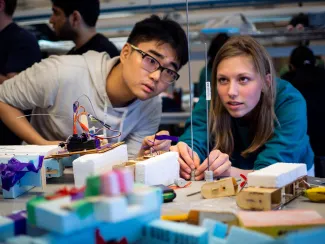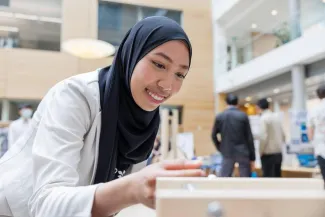
Gibson Clark, Nathaniel McCallum, Auke Visser, Francesco Pero, Jordan Nevens
- Community Partner: Ocean Exploration Trust (OET)
- Degree:
- Bachelor of Applied Science
- Program:
- Campus: Vancouver
Our project
Remotely operated vehicle (ROV) Hercules, a central part of the OET's Nautilus Exploration Program, currently jettisons steel plates to increase its buoyancy as it collects samples from the sea floor. Although a simple solution, it is disruptive to the sea floor as the plates are left at the bottom during each dive.
The design challenge proposed by OET was to develop a solution that provides active buoyancy adjustment without causing environmental disruption or impact to be used by ROV Hercules during a dive. Our solution achieves this through a seawater ballast system with a spherical titanium tank and hydraulically powered water pump, operable to 4000 metres.
Our inspiration
OET streams live video footage of all their explorations via the Nautilus Live webpage. Watching subsea vehicles like ROV Hercules augment the human capacity to explore and better understand new places on our planet resonated with us and inspired the initial inquiry to see if OET had an ROV engineering challenge suitable for a capstone team to take on.
Our biggest challenge
From a technical perspective, designing a subsea hydraulic system was new for all team members, creating an incredibly steep learning curve. Surmounting this curve was complicated by the fact that there are very few solutions to learn from when facing design and operation challenges 4000 metres below the ocean surface.
Additionally, from a course perspective, the team was challenged to divide resources in order to embark on both a full-scale design for our client in parallel with a working, functional prototype for demonstration and testing purposes.
What excited us most
Most engineering design projects our team members have worked on had more trivial solutions: problems that can likely be solved with many "off the shelf" options, with only optimization of the design needed.
This unprecedented design project required us to spend the majority of the year brainstorming and reaching out to industry experts for advice; this project provided a unique challenge we had never experienced before.
In addition to the challenge of this project, being reminded of the application of the project to deep-sea research through the constant live streams was exciting for the team.
The most interesting/surprising thing we learned
From an engineering design perspective, it was incredible to realize how important good and efficient communication of an idea can be. Design reviews and presentations easily become bogged down by attempts to boil all the intricacies of a solution down into something communicable in a short period of time. We were surprised by the complexity that intense pressure and temperature gradients add to a design process, as well as the robustness of hydraulic solutions and some elegant ways they can be used to manage immense ocean pressures. It was also interesting to learn that most military submarines never exceed 1000 metres in depth, while ROV Hercules can reach 4000 metres.
Our project's future
The ROV Engineering team at OET will review the proposed Hydraulic Buoyancy Engine and, given approval of more funding, continue to develop the design into the testing and implementation stages for integration with ROV Hercules.






